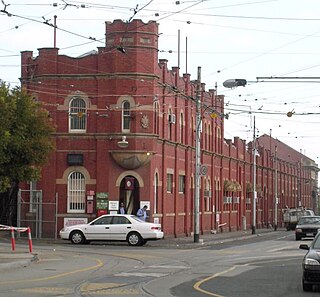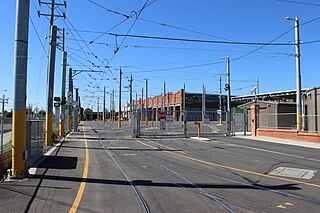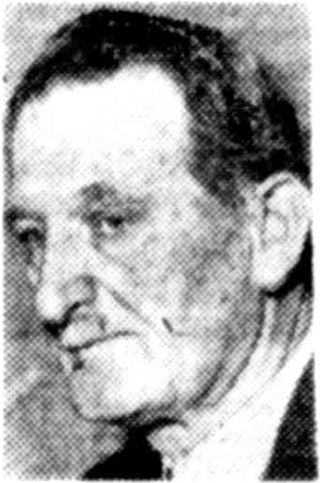
The Melbourne tramway network is a tramway system serving the city of Melbourne, Victoria, Australia. The tramway network is centred around the Melbourne central business district (CBD) and consists of approximately 1,700 tram stops across 24 routes. It is the largest operational urban tram network in the world and one of the most used, with more than 500 trams and 250 kilometres of double tram track. It served a patronage of 206 million over the year 2017-2018. Trams are the second most utilised form of public transport in Melbourne after the city's metropolitan commuter railway network.

Riversdale railway station is a commuter railway station on the Alamein line, serving the eastern Melbourne suburb of Camberwell in Victoria, Australia. Riversdale is a ground-level unstaffed station, featuring two side platforms. It opened on 30 May 1890.

Melbourne tram route 72 is operated by Yarra Trams on the Melbourne tram network from Melbourne University to Camberwell. The 16.8 kilometre route is operated out of Malvern depot with Z and D class trams.

Melbourne tram route 96 is operated by Yarra Trams on the Melbourne tram network from Brunswick East to St Kilda Beach. The 13.9 kilometre route is operated out of Southbank depot and Preston depot with C2, E class, and on occasion A class trams.

Melbourne tram route 75 is operated by Yarra Trams on the Melbourne tram network from Vermont South to Central Pier. The 22.8 kilometre route is operated out of Camberwell depot with A and B class trams. It is the longest route on the network.

Melbourne tram route 70 is operated by Yarra Trams on the Melbourne tram network from Waterfront City to Wattle Park. The 16.5 kilometre route is operated out of Camberwell depot with A and B class trams.

Melbourne tram route 109 is operated by Yarra Trams on the Melbourne tram network from Box Hill to Port Melbourne. The 19.3 kilometre route is operated out of Kew depot with A and C class trams.

The A-class Melbourne tram is a class of bogie trams that operate on the Melbourne tram network. Seventy were built by Comeng, Dandenong between 1984 and 1987 in two batches, 28 A1s and 42 A2s, with only minor differences. They are the smallest trams by capacity currently operating on the network.

Melbourne tram route 86 is operated by Yarra Trams on the Melbourne tram network from Bundoora RMIT to Waterfront City. The 22.2-kilometre (13.8 mi) route is operated out of Preston depot with E class trams.

Melbourne tram route 11 is a tram route on the Melbourne tramway network serving the city of Melbourne in Victoria, Australia. Operated by Yarra Trams, the route is coloured turqoise green and extends from West Preston to Victoria Harbour over 13.4-kilometre (8.3 mi) of double track via St Georges Road, Fitzroy and Collins Street. It is serviced out of Preston depot utilising E class trams.

The Melbourne & Metropolitan Tramways Board (MMTB) was a government-owned authority that was responsible for the tram network in Melbourne, Australia between 1919 and 1983, when it was merged into the Metropolitan Transit Authority. It had been formed by the merger of a number of smaller tramway trusts and companies that operated throughout the city.

Malvern tram depot is located on Coldblo Road, Armadale, Victoria, a suburb in Melbourne, Victoria, Australia. Operated by Yarra Trams, it is one of eight tram depots on the Melbourne tram network.

The Z-class are single-unit bogie trams that operate on the Melbourne tram network. Between 1975 and 1983, 230 trams spanning three sub-classes were built by Comeng, Dandenong. The design was based on two similar Gothenburg tram models, and a prototype built by the Melbourne & Metropolitan Tramways Board. While the Z1 and Z2-class trams were very similar, the Z3-class had significant design changes.

The W-class trams are a family of electric trams built by the Melbourne & Metropolitan Tramways Board (MMTB) between 1923 and 1956. Over the 33 years of production, 752 vehicles spanning 12 sub-classes were constructed, the majority at the MMTB's Preston Workshops.

Kew tram depot is located on the corner of Barkers Road and High Street, Kew, a suburb of Melbourne, Australia. Operated by Yarra Trams, it is one of eight tram depots on the Melbourne tram network.

Essendon tram depot is located on Mount Alexander Road, Travancore, a suburb of Melbourne, Victoria, Australia. Operated by Yarra Trams, it is one of eight tram depots on the Melbourne tram network. Despite the name, the depot is located three kilometres from the suburb of Essendon.

Preston Workshops is the heavy maintenance facility for the Melbourne tram network. The workshop is located on a block surrounded by Miller Street, St Georges Road, Oakover Road and the Mernda railway line in Preston, a suburb in Melbourne, Victoria, Australia. Following a major redevelopment in April 2016, it also became an operational depot under the name New Preston Depot, taking over from East Preston.

East Preston tram depot was a depot on the Yarra Trams network in Melbourne. Located on Plenty Road, East Preston, it opened in 1955 to coincide with the reintroduction of trams to Bourke Street. It closed in April 2016.

Hector Hercules Bell CBE was an Australian contractor, municipal councillor, and tramway administrator. Following an initially itinerant working life, Bell married and became a successful businessman, later being elected as a councillor to Richmond City Council. Bell was appointed to the board of the Melbourne & Metropolitan Tramways Board (MMTB) in 1919, and became the MMTB's second chairman in 1936, a position he held until 1949. Under Bell, the MMTB converted the remaining cable trams to electric trams or buses, increased the MMTB's usage of buses, and work towards modernising the tram system, while returning strong surpluses. Bell was primarily a supporter of electric trams advocating their advantages over buses. During his career he ran for a seat on the Victorian Legislative Council, and was occasionally accused of unethical behaviour.
The Melbourne tram network began in 1884 with the construction of the Fairfield Horse Tramway. However, the purpose of the line was to increase land prices in the area, and it soon closed during the depression in 1890. The first genuine attempt to construct a tramway network was the construction of the Richmond cable tram line by the Melbourne Tramway & Omnibus Company in 1885. Over the next few years, 16 more cable tram lines were constructed, as well as numerous other horse tramways. The depression of the early 1890s slowed further expansion of the cable network. The first electric tram line was the Box Hill and Doncaster tramway which opened in 1889. This was a pioneering line in what was then the countryside and thus didn't receive much patronage. It closed in 1896. The next attempt at an electric tramway was Victorian Railways' St Kilda to Brighton line, which opened in 1906. Later that year, the North Melbourne Electric Tramway & Lighting Company opened lines to Essendon and Maribyrnong. Many local councils formed their own tramway trusts and built tramways within their own constituency. The most successful of these was the Prahran & Malvern Tramways Trust.




















